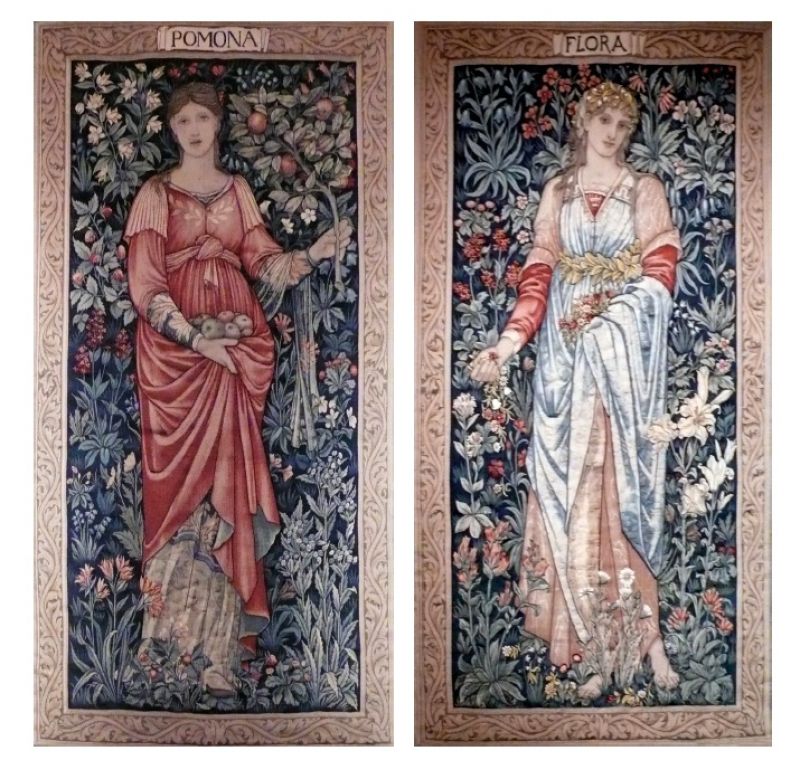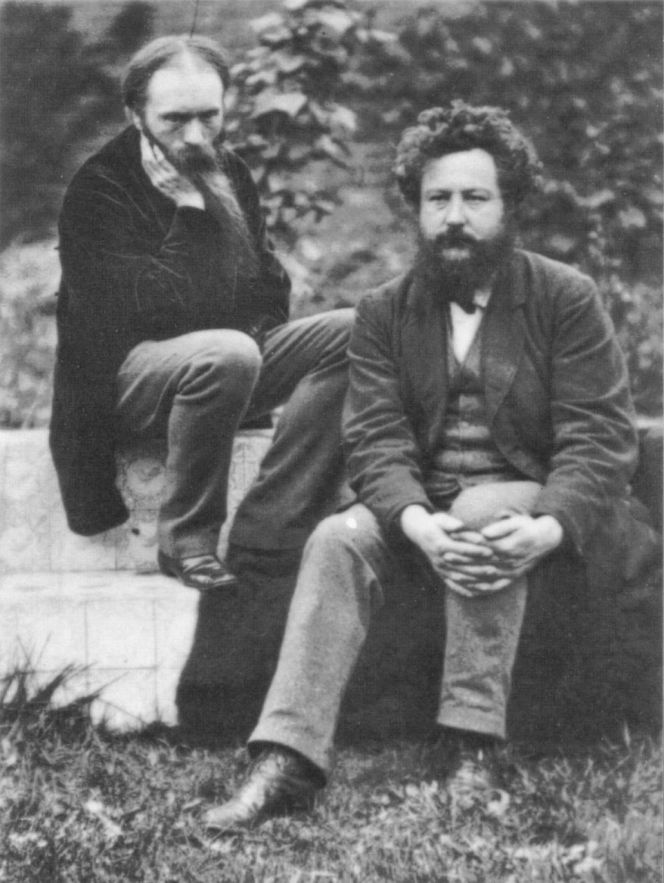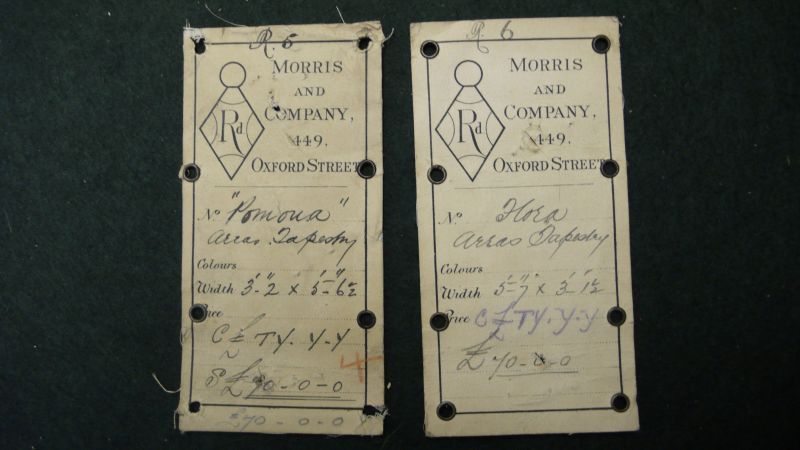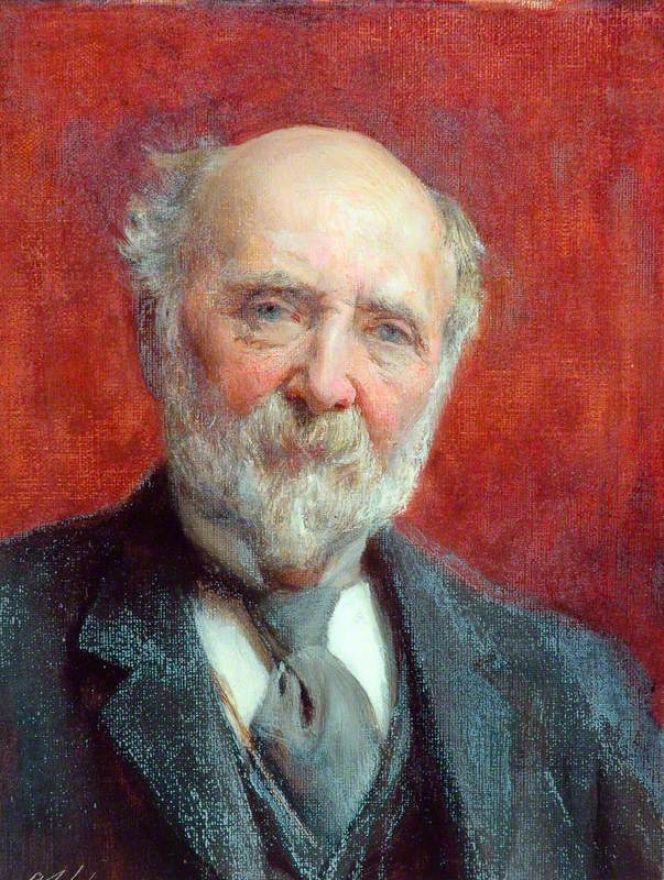ikfoundation.org
The IK Foundation
Promoting Natural & Cultural History
Since 1988


 Crowdfunding Campaign
Crowdfunding Campaignkeep knowledge open, connected, and growing on this textile history resource...
TWO TAPESTRY PANELS
– Woven by Morris & Company around Year 1900
Robert Elliott Pannett (1834-1920) was a Whitby solicitor who held various positions in local government during his professional life. He was also, for many years, deeply engaged with the Whitby Literary & Philosophical Society, of which he became a member in 1861 before serving on the Committee from 1862 to 1920. As a collector of fine arts he purchased the woven tapestries Flora and Pomona from Morris & Company in Oxford Street, London. The company’s letters of August-December 1900 to Pannett negotiating the purchase of these two woven tapestry panels have also been preserved, and they add a further dimension to these beautiful textiles; one can read in them about problems that arose about the purchase, the price and how best the tapestries should be hung.
 Edward Burne-Jones’ tapestries Flora and Pomona. (Collection: Pannett Art Gallery, Whitby, North Yorkshire, United Kingdom). Photo: Viveka Hansen, The IK Foundation, London
Edward Burne-Jones’ tapestries Flora and Pomona. (Collection: Pannett Art Gallery, Whitby, North Yorkshire, United Kingdom). Photo: Viveka Hansen, The IK Foundation, LondonWilliam Morris (1834-1896) considered tapestry ‘the noblest of the weaving arts’, and these textiles worked by Morris & Company at their Merton Abbey Workshop are of the highest quality from all points of view: artistic, technical and material. The panels are made from a strong cotton warp completely covered by an inwoven weft of yarn, which is mostly wool but with some silk for added lustre. A great many nuances have been used to bring out the right gradations and shifts of shade, using a tightly packed weave with a warp of about eight threads per centimetre. The weaving was done from the long side with near life-size figures, and is entirely in style with earlier tapestries in both technique and pattern. Even the choice of colours seems to come from an earlier age with natural dyes – developed in the workshop at Merton Abbey – even if some of the yarns were probably coloured synthetically. The design, by Sir Edward Burne-Jones (1833-1898), was inspired by Roman mythology. The two female figures are believed to represent the goddesses: Pomona, who reigned over orchards and fruit-trees, and Flora, whose sphere was the spring and flowers. The inspiration of the weave was Arras work, which reached its peak in the 14th to 15th centuries in France in large-scale tapestries.
 The design of Pomona and Flora was made by Edward Burne-Jones already in 1884. Burne-Jones (left) here portrayed together with William Morris, by the photographer Frederick Hollyer in 1874 (Wikimedia Commons).
The design of Pomona and Flora was made by Edward Burne-Jones already in 1884. Burne-Jones (left) here portrayed together with William Morris, by the photographer Frederick Hollyer in 1874 (Wikimedia Commons).These two woven tapestry panels were popular motifs around the turn of the century and appeared in various designs with Flora and Pomona framed against a flower-strewn background. At least eleven variants of the first were woven and six of the second, and thanks to Pannett’s efforts, two of these extremely fine woven tapestries came to Whitby.
The first letter from Morris & Company to Pannett is dated 27 August in 1900: ‘Dear Sir, We beg to acknowledge the receipt of the two panels of Arras Tapestry. With reference to going in the first refusal of these tapestries, we have several enquiries for this work just now and as we have just been awarded a Grand Prize Diploma for the tapestries at the Paris Exhibition, we shall, in all probability, be getting more so that we feel that we are unable to reserve them for you for any length of time but shall be pleased to hold them over for one week from the date of this letter.’
The following two letters – 31 August and 1 September – refer to separate lists giving explanations and answers to questions from Pannett about the design and hanging of the tapestries. Then a letter of 11 September informs him that the tapestries have now been sent ‘on approval’, explains how they should be hung to look at their best, and gives the price: ‘...The prices already quoted for the Tapestries are absolutely the lowest we could take; we consider them thoroughly good value for the money.’
 The original price-tickets from 1900 of the Flora and Pomona tapestries, purchased by Robert Elliott Pannett in Whitby. (Collection: Whitby Museum, Library & Archive, 0087/2/3/1-2). Photo: Viveka Hansen, The IK Foundation, London.
The original price-tickets from 1900 of the Flora and Pomona tapestries, purchased by Robert Elliott Pannett in Whitby. (Collection: Whitby Museum, Library & Archive, 0087/2/3/1-2). Photo: Viveka Hansen, The IK Foundation, London.The price of £140 was a large sum of money in 1900, but tapestry weaving is an extremely time-consuming process that demands many hundred hours of work from the man or woman doing the weaving. Pannett seems to have asked more questions about the hanging, which are again answered in the next letter, dated 18 September, though Morris & Company now ask with some impatience for a definite answer as to whether he intends to buy them or not: ‘...We have an enquiry for the panels and have to give our client a definite reply tomorrow afternoon, may we therefore ask you to kindly wire us for decision in the morning and if you are returning with one or both the panels, to do so per passenger train.’
 A somewhat later portrait of Robert Elliott Pannett, dating ca 1910. Oil on canvas by Arthur Stockdale Cope (1857-1940). (Courtesy of: Pannett Art Gallery, Whitby, North Yorkshire, United Kingdom).
A somewhat later portrait of Robert Elliott Pannett, dating ca 1910. Oil on canvas by Arthur Stockdale Cope (1857-1940). (Courtesy of: Pannett Art Gallery, Whitby, North Yorkshire, United Kingdom).Pannett confirmed his decision, and the next day, Morris & Company wrote: ‘We are obliged for your telegram and are pleased to hear that you have decided to keep the Flora and Pomona Tapestries and have accordingly charged them to your account.’
As early as 20 September, they sent another letter confirming that they were willing to line the back and add ‘pockets (or slots) at the top of the panels, made of the lining through which the rods would run...’ without further charge and giving further advice on how best to arrange the tapestries. Then, on the 24th of the same month, they confirmed an agreement about the linings and fittings for putting up the tapestries, while a letter of 28 September gave final advice on hanging. During this time, Pannett had returned the tapestries to Morris & Company for help with the packing and more hanging details, and in this connection, the firm wrote again on 10 October to explain that they had sent ‘a parcel of Arras tapestry’ that would be delivered shortly. They also sent a bill for a total of £141.10s.6d. Nor did the correspondence stop here since Pannett was not entirely satisfied with the Flora tapestry, and Morris & Company answered on 23 November that there was a possibility of exchanging it for another similar one. It seems, however, that this did not happen since a letter dated 5 December states that the said ‘Flora panel shown at the Leeds Exhibition’ had been sold and, therefore, was no longer open to exchange. Morris & Company tried their best to convince Pannett that the details that had disturbed him depended on the hanging and lighting of the tapestries. Both parties now seem to have been satisfied and their correspondence ended. Well over a hundred years later both tapestries hang in the Pannett Art Gallery in Whitby, their colours scarcely faded.
Sources:
- Hansen, Viveka, The Textile History of Whitby 1700-1914 – A lively coastal town between the North Sea and North York Moors, London & Whitby 2015 (pp. 46-48).
- Pannett Art Gallery, Whitby, United Kingdom (studies of the tapestries, at the gallery in 2007).
- The Public Catalogue Foundation, Oil Paintings in Public Ownership in North Yorkshire, London 2006.
- Whitby Museum, Library & Archive, United Kingdom. (Correspondence & price-tickets: Morris & Company, Oxford Street to Robert Elliott Pannett, 0087/2/3/1-16 E).
More in Books & Art:
Essays
The iTEXTILIS is a division of The IK Workshop Society – a global and unique forum for all those interested in Natural & Cultural History.
Open Access Essays by Textile Historian Viveka Hansen
Textile historian Viveka Hansen offers a collection of open-access essays, published under Creative Commons licenses and freely available to all. These essays weave together her latest research, previously published monographs, and earlier projects dating back to the late 1980s. Some essays include rare archival material — originally published in other languages — now translated into English for the first time. These texts reveal little-known aspects of textile history, previously accessible mainly to audiences in Northern Europe. Hansen’s work spans a rich range of topics: the global textile trade, material culture, cloth manufacturing, fashion history, natural dyeing techniques, and the fascinating world of early travelling naturalists — notably the “Linnaean network” — all examined through a global historical lens.
Help secure the future of open access at iTEXTILIS essays! Your donation will keep knowledge open, connected, and growing on this textile history resource.
been copied to your clipboard




– a truly European organisation since 1988
Legal issues | Forget me | and much more...
You are welcome to use the information and knowledge from
The IK Workshop Society, as long as you follow a few simple rules.
LEARN MORE & I AGREE







